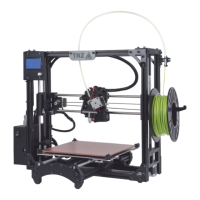Slic3r in Depth
Figure 3.40: Support infill pattern: Honeycomb
Pattern Spacing
determines the distance between support lines, and
is akin to infill density apart from being defined only in mm. If changing
this attribute take into account the width of the support extrusion and the
amount of support material that will adhere to the object.
Care should be taken to choose a support pattern which matches the
model, where the support material attaches perpendicularly to the wall
of the object, rather than in parallel, so it will be easy to remove. If the
support structure does run along the length of a wall then the
Pattern
Angle option allows the direction of the support lines to be rotated.
Figure 3.41: Example of pattern angle rotated 45
◦
.
3.5 Configuration Organization
There are two ways in which to organize the configuration settings: exporting
and importing the configuration settings, and profiles. The former is
available in both simple and expert mode, whereas profiles is only available
in expert mode.
Exporting and Importing Configuration
The current set of configuration options can be simply exported via the
Export Config
File menu option. This saves all the values into a text file
82

